Microsoft AZ-303 Exam Practice Questions (P. 5)
- Full Access (334 questions)
- Six months of Premium Access
- Access to one million comments
- Seamless ChatGPT Integration
- Ability to download PDF files
- Anki Flashcard files for revision
- No Captcha & No AdSense
- Advanced Exam Configuration
Question #41
HOTSPOT -
You create a virtual machine scale set named Scale1. Scale1 is configured as shown in the following exhibit.
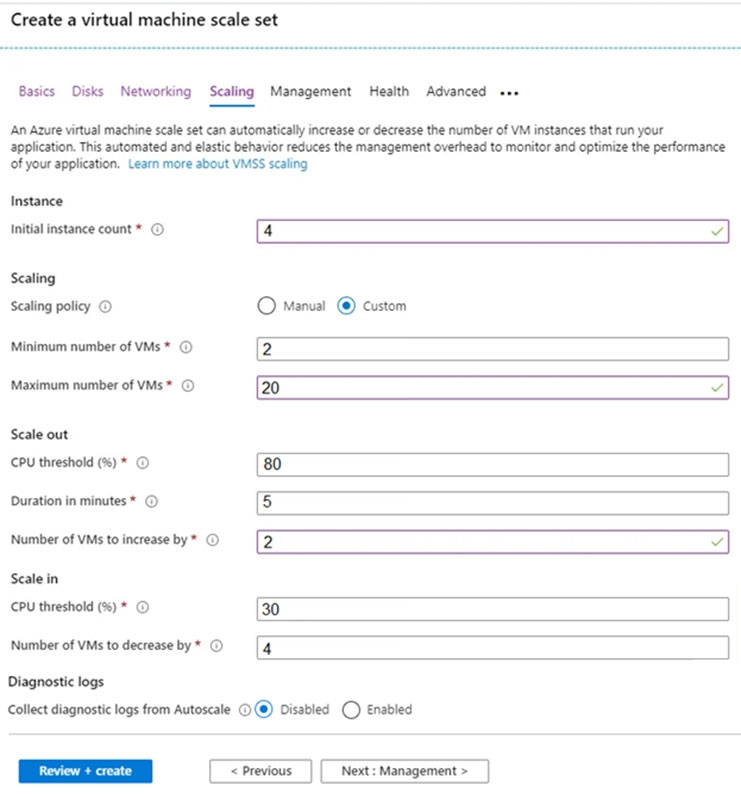
Use the drop-down menus to select the answer choice that completes each statement based on the information presented in the graphic.
NOTE: Each correct selection is worth one point.
Hot Area:

You create a virtual machine scale set named Scale1. Scale1 is configured as shown in the following exhibit.

Use the drop-down menus to select the answer choice that completes each statement based on the information presented in the graphic.
NOTE: Each correct selection is worth one point.
Hot Area:

Correct Answer:

Box 1:
The Autoscale scale out rule increases the number of VMs by 2 if the CPU threshold is 80% or higher. The initial instance count is 4 and rises to 6 when the 2 extra instances of VMs are added.
Box 2:
The Autoscale scale in rule decreases the number of VMs by 4 if the CPU threshold is 30% or lower. The initial instance count is 4 and thus cannot be reduced to
0 as the minimum instances is set to 2. Instances are only added when the CPU threshold reaches 80%.
Reference:
https://docs.microsoft.com/en-us/azure/azure-monitor/platform/autoscale-overview https://docs.microsoft.com/en-us/azure/azure-monitor/platform/autoscale-best-practices https://docs.microsoft.com/en-us/azure/azure-monitor/platform/autoscale-common-scale-patterns

Box 1:
The Autoscale scale out rule increases the number of VMs by 2 if the CPU threshold is 80% or higher. The initial instance count is 4 and rises to 6 when the 2 extra instances of VMs are added.
Box 2:
The Autoscale scale in rule decreases the number of VMs by 4 if the CPU threshold is 30% or lower. The initial instance count is 4 and thus cannot be reduced to
0 as the minimum instances is set to 2. Instances are only added when the CPU threshold reaches 80%.
Reference:
https://docs.microsoft.com/en-us/azure/azure-monitor/platform/autoscale-overview https://docs.microsoft.com/en-us/azure/azure-monitor/platform/autoscale-best-practices https://docs.microsoft.com/en-us/azure/azure-monitor/platform/autoscale-common-scale-patterns
send
light_mode
delete
Question #42
You plan to automate the deployment of a virtual machine scale set that uses the Windows Server 2016 Datacenter image.
You need to ensure that when the scale set virtual machines are provisioned, they have web server components installed.
Which two actions should you perform? Each correct answer presents part of the solution.
NOTE: Each correct selection is worth one point.
You need to ensure that when the scale set virtual machines are provisioned, they have web server components installed.
Which two actions should you perform? Each correct answer presents part of the solution.
NOTE: Each correct selection is worth one point.
- AUpload a configuration script.Most Voted
- BCreate an Azure policy.
- CModify the extensionProfile section of the Azure Resource Manager template.Most Voted
- DCreate a new virtual machine scale set in the Azure portal.
- ECreate an automation account.
Correct Answer:
CD
Reference:
https://docs.microsoft.com/en-us/azure/virtual-machine-scale-sets/tutorial-install-apps-template
CD
Reference:
https://docs.microsoft.com/en-us/azure/virtual-machine-scale-sets/tutorial-install-apps-template
send
light_mode
delete
Question #43
HOTSPOT -
You have several Azure virtual machines on a virtual network named VNet1. Vnet1 has two subnets that have 10.2.0.0/24 and 10.2.9.0/24 address spaces.
You configure an Azure Storage account as shown in the following exhibit.
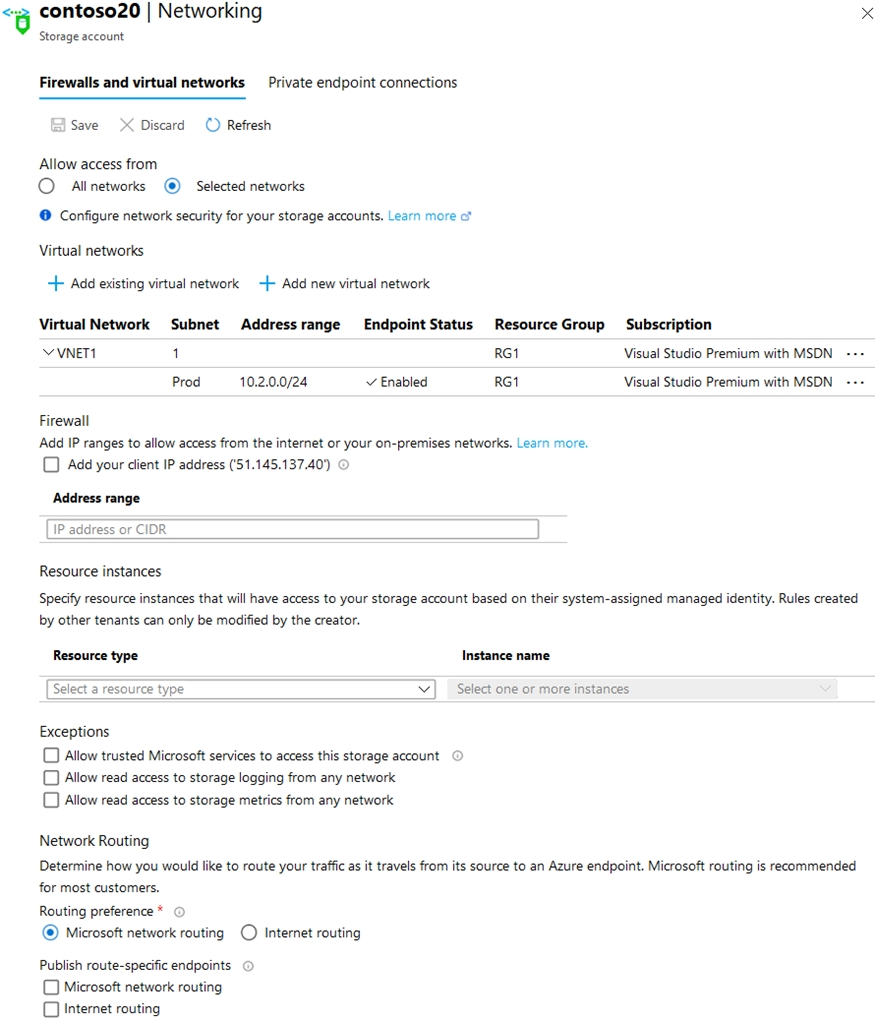
Use the drop-down menus to select the answer choice that completes each statement based on the information presented in the graphic.
NOTE: Each correct selection is worth one point.
Hot Area:
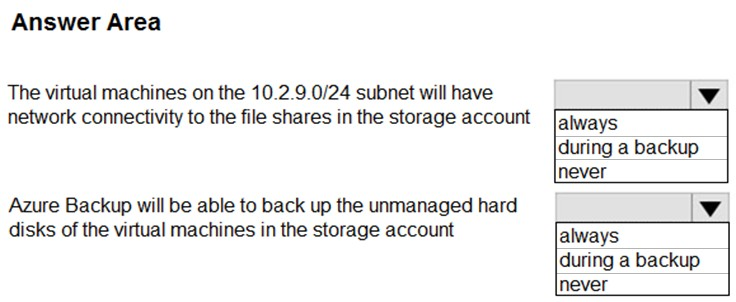
You have several Azure virtual machines on a virtual network named VNet1. Vnet1 has two subnets that have 10.2.0.0/24 and 10.2.9.0/24 address spaces.
You configure an Azure Storage account as shown in the following exhibit.

Use the drop-down menus to select the answer choice that completes each statement based on the information presented in the graphic.
NOTE: Each correct selection is worth one point.
Hot Area:

Correct Answer:
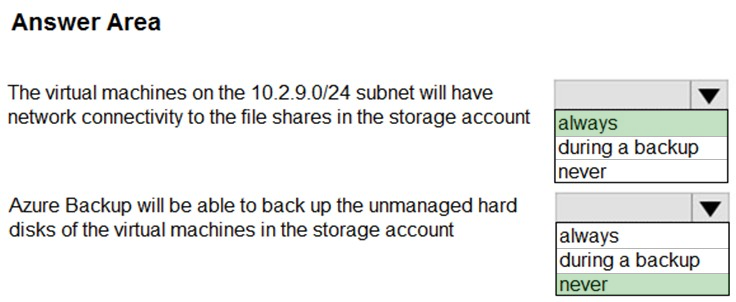
Box 1: always -
Endpoint status is enabled.
Box 2: Never -
After you configure firewall and virtual network settings for your storage account, select Allow trusted Microsoft services to access this storage account as an exception to enable Azure Backup service to access the network restricted storage account.
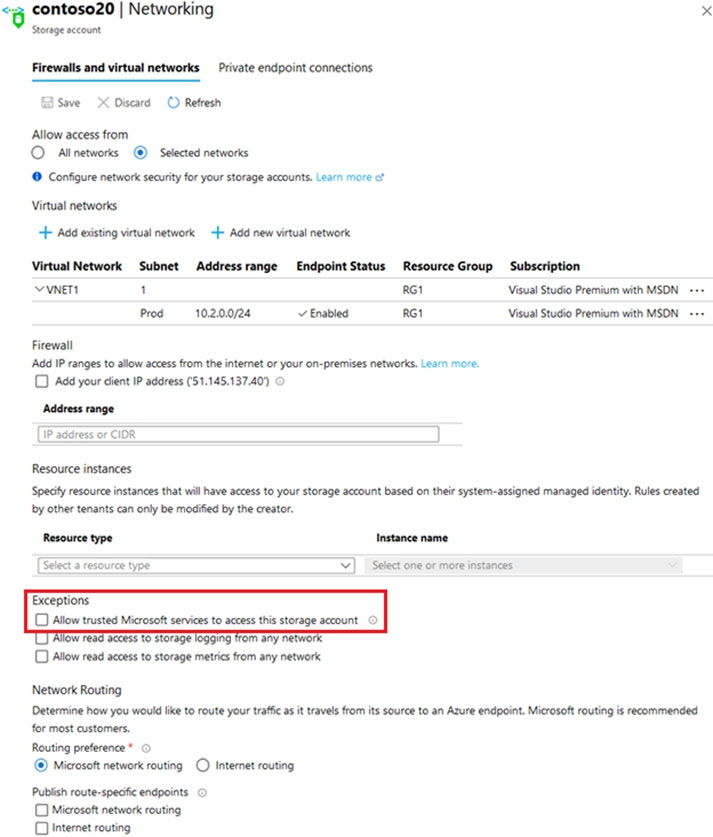
Reference:
https://docs.microsoft.com/en-us/azure/storage/files/storage-how-to-use-files-windows https://azure.microsoft.com/en-us/blog/azure-backup-now-supports-storage-accounts-secured-with-azure-storage-firewalls-and-virtual-networks/

Box 1: always -
Endpoint status is enabled.
Box 2: Never -
After you configure firewall and virtual network settings for your storage account, select Allow trusted Microsoft services to access this storage account as an exception to enable Azure Backup service to access the network restricted storage account.

Reference:
https://docs.microsoft.com/en-us/azure/storage/files/storage-how-to-use-files-windows https://azure.microsoft.com/en-us/blog/azure-backup-now-supports-storage-accounts-secured-with-azure-storage-firewalls-and-virtual-networks/
send
light_mode
delete
Question #44
HOTSPOT -
You create and save an Azure Resource Manager template named Template1 that includes the following four sections.
Section1.

Section2.

Section3.

Section4.

You deploy Template1.
For each of the following statements, select Yes if the statement is true. Otherwise, select No.
NOTE: Each correct selection is worth one point.
Hot Area:
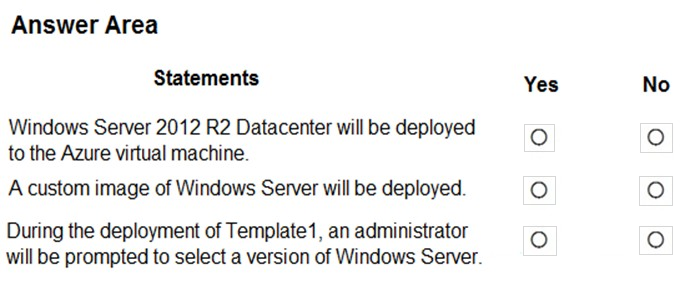
You create and save an Azure Resource Manager template named Template1 that includes the following four sections.
Section1.

Section2.

Section3.

Section4.

You deploy Template1.
For each of the following statements, select Yes if the statement is true. Otherwise, select No.
NOTE: Each correct selection is worth one point.
Hot Area:

send
light_mode
delete
Question #45
DRAG DROP -
You have virtual machines (VMs) that run a mission-critical application.
You need to ensure that the VMs never experience down time.
What should you recommend? To answer, drag the appropriate solutions to the correct scenarios. Each solution may be used once, more than once, or not at all.
You may need to drag the split bar between panes or scroll to view content.
NOTE: Each correct selection is worth one point
Select and Place:

You have virtual machines (VMs) that run a mission-critical application.
You need to ensure that the VMs never experience down time.
What should you recommend? To answer, drag the appropriate solutions to the correct scenarios. Each solution may be used once, more than once, or not at all.
You may need to drag the split bar between panes or scroll to view content.
NOTE: Each correct selection is worth one point
Select and Place:

Correct Answer:

Box 1: Scale set -
A virtual machine scale set allows you to deploy and manage a set of identical, autoscaling virtual machines.
Box 2: Availability Set -
An Availability Set is a logical grouping capability for isolating VM resources from each other when they're deployed. Azure makes sure that the VMs you place within an Availability Set run across multiple physical servers, compute racks, storage units, and network switches. If a hardware or software failure happens, only a subset of your VMs are impacted and your overall solution stays operational. Availability Sets are essential for building reliable cloud solutions.
Box 3: Fault domain -
A fault domain is a logical group of underlying hardware that share a common power source and network switch, similar to a rack within an on-premises datacenter. As you create VMs within an availability set, the Azure platform automatically distributes your VMs across these fault domains. This approach limits the impact of potential physical hardware failures, network outages, or power interruptions.
Incorrect Answers:
An update domain is a group of VMs and underlying physical hardware that can be rebooted at the same time.
Reference:
https://docs.microsoft.com/en-us/azure/virtual-machines/windows/tutorial-create-vmss https://docs.microsoft.com/en-us/azure/virtual-machines/windows/tutorial-availability-sets

Box 1: Scale set -
A virtual machine scale set allows you to deploy and manage a set of identical, autoscaling virtual machines.
Box 2: Availability Set -
An Availability Set is a logical grouping capability for isolating VM resources from each other when they're deployed. Azure makes sure that the VMs you place within an Availability Set run across multiple physical servers, compute racks, storage units, and network switches. If a hardware or software failure happens, only a subset of your VMs are impacted and your overall solution stays operational. Availability Sets are essential for building reliable cloud solutions.
Box 3: Fault domain -
A fault domain is a logical group of underlying hardware that share a common power source and network switch, similar to a rack within an on-premises datacenter. As you create VMs within an availability set, the Azure platform automatically distributes your VMs across these fault domains. This approach limits the impact of potential physical hardware failures, network outages, or power interruptions.
Incorrect Answers:
An update domain is a group of VMs and underlying physical hardware that can be rebooted at the same time.
Reference:
https://docs.microsoft.com/en-us/azure/virtual-machines/windows/tutorial-create-vmss https://docs.microsoft.com/en-us/azure/virtual-machines/windows/tutorial-availability-sets
send
light_mode
delete
Question #46
You have an Azure subscription.
You have an on-premises virtual machine named VM1. The settings for VM1 are shown in the exhibit. (Click the Exhibit tab.)
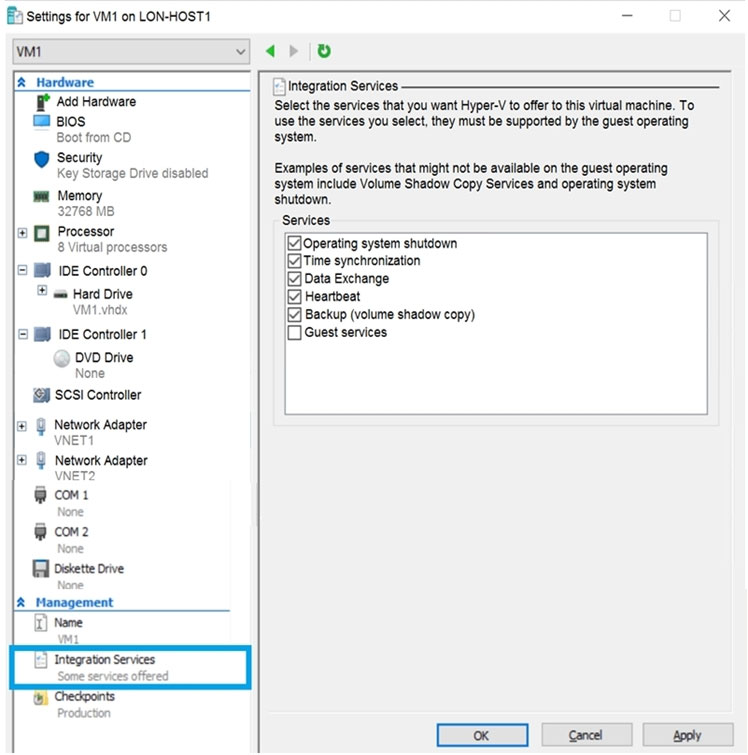
You need to ensure that you can use the disks attached to VM1 as a template for Azure virtual machines.
What should you modify on VM1?
You have an on-premises virtual machine named VM1. The settings for VM1 are shown in the exhibit. (Click the Exhibit tab.)

You need to ensure that you can use the disks attached to VM1 as a template for Azure virtual machines.
What should you modify on VM1?
- Athe memory
- BIntegration Services
- Cthe hard driveMost Voted
- Dthe network adapters
- Ethe processor
Correct Answer:
C
From the exhibit we see that the disk is in the VHDX format.
Before you upload a Windows virtual machines (VM) from on-premises to Microsoft Azure, you must prepare the virtual hard disk (VHD or VHDX). Azure supports only generation 1 VMs that are in the VHD file format and have a fixed sized disk. The maximum size allowed for the VHD is 1,023 GB. You can convert a generation 1 VM from the VHDX file system to VHD and from a dynamically expanding disk to fixed-sized.
Reference:
https://docs.microsoft.com/en-us/azure/virtual-machines/windows/prepare-for-upload-vhd-image?toc=azure virtual-machines windows toc.json
C
From the exhibit we see that the disk is in the VHDX format.
Before you upload a Windows virtual machines (VM) from on-premises to Microsoft Azure, you must prepare the virtual hard disk (VHD or VHDX). Azure supports only generation 1 VMs that are in the VHD file format and have a fixed sized disk. The maximum size allowed for the VHD is 1,023 GB. You can convert a generation 1 VM from the VHDX file system to VHD and from a dynamically expanding disk to fixed-sized.
Reference:
https://docs.microsoft.com/en-us/azure/virtual-machines/windows/prepare-for-upload-vhd-image?toc=azure virtual-machines windows toc.json
send
light_mode
delete
Question #47
Your company has an office in Seattle.
You have an Azure subscription that contains a virtual network named VNET1.
You create a site-to-site VPN between the Seattle office and VNET1.
VNET1 contains the subnets shown in the following table.

You need to route all Internet-bound traffic from Subnet1 to the Seattle office.
What should you create?
You have an Azure subscription that contains a virtual network named VNET1.
You create a site-to-site VPN between the Seattle office and VNET1.
VNET1 contains the subnets shown in the following table.

You need to route all Internet-bound traffic from Subnet1 to the Seattle office.
What should you create?
- Aa route for GatewaySubnet that uses the virtual network gateway as the next hop
- Ba route for Subnet1 that uses the local network gateway as the next hop
- Ca route for Subnet1 that uses the virtual network gateway as the next hopMost Voted
- Da route for GatewaySubnet that uses the local network gateway as the next hop
Correct Answer:
C
A route with the 0.0.0.0/0 address prefix instructs Azure how to route traffic destined for an IP address that is not within the address prefix of any other route in a subnet's route table. When a subnet is created, Azure creates a default route to the 0.0.0.0/0 address prefix, with the Internet next hop type. We need to create a custom route in Azure to use a virtual network gateway in the Seattle office as the next hop.
Reference:
https://docs.microsoft.com/en-us/azure/virtual-network/virtual-networks-udr-overview
C
A route with the 0.0.0.0/0 address prefix instructs Azure how to route traffic destined for an IP address that is not within the address prefix of any other route in a subnet's route table. When a subnet is created, Azure creates a default route to the 0.0.0.0/0 address prefix, with the Internet next hop type. We need to create a custom route in Azure to use a virtual network gateway in the Seattle office as the next hop.
Reference:
https://docs.microsoft.com/en-us/azure/virtual-network/virtual-networks-udr-overview
send
light_mode
delete
Question #48
HOTSPOT -
You have Azure Storage accounts as shown in the following exhibit.
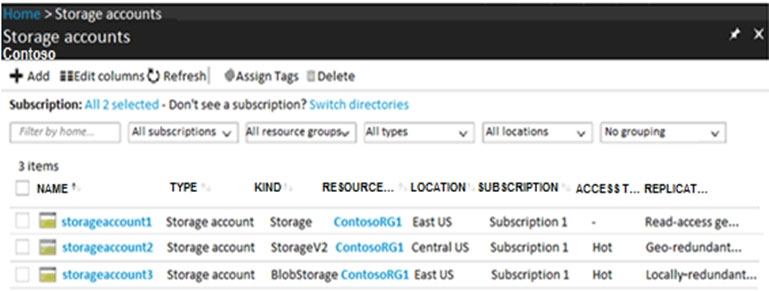
Use the drop-down menus to select the answer choice that completes each statement based on the information presented in the graphic.
NOTE: Each correct selection is worth one point.
Hot Area:
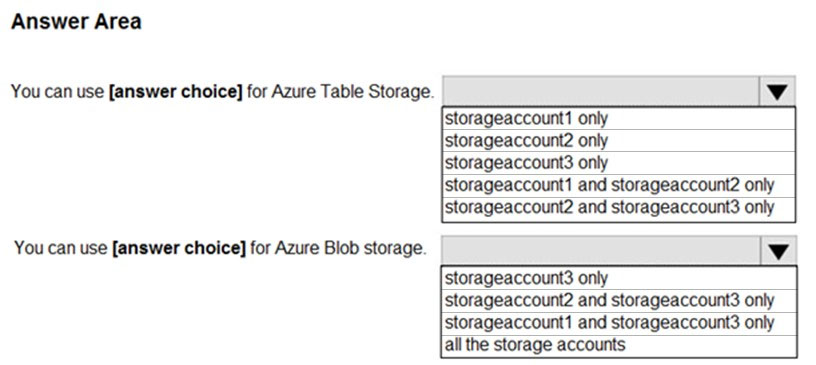
You have Azure Storage accounts as shown in the following exhibit.

Use the drop-down menus to select the answer choice that completes each statement based on the information presented in the graphic.
NOTE: Each correct selection is worth one point.
Hot Area:

Correct Answer:
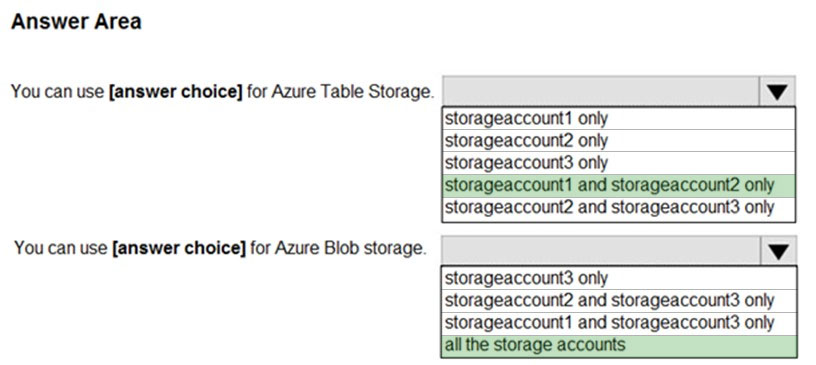
Box 1: storageaccount1 and storageaccount2 only
Box 2: All the storage accounts -
Note: The three different storage account options are: General-purpose v2 (GPv2) accounts, General-purpose v1 (GPv1) accounts, and Blob storage accounts.
✑ General-purpose v2 (GPv2) accounts are storage accounts that support all of the latest features for blobs, files, queues, and tables.
✑ Blob storage accounts support all the same block blob features as GPv2, but are limited to supporting only block blobs.
✑ General-purpose v1 (GPv1) accounts provide access to all Azure Storage services, but may not have the latest features or the lowest per gigabyte pricing.
Reference:
https://docs.microsoft.com/en-us/azure/storage/common/storage-account-options

Box 1: storageaccount1 and storageaccount2 only
Box 2: All the storage accounts -
Note: The three different storage account options are: General-purpose v2 (GPv2) accounts, General-purpose v1 (GPv1) accounts, and Blob storage accounts.
✑ General-purpose v2 (GPv2) accounts are storage accounts that support all of the latest features for blobs, files, queues, and tables.
✑ Blob storage accounts support all the same block blob features as GPv2, but are limited to supporting only block blobs.
✑ General-purpose v1 (GPv1) accounts provide access to all Azure Storage services, but may not have the latest features or the lowest per gigabyte pricing.
Reference:
https://docs.microsoft.com/en-us/azure/storage/common/storage-account-options
send
light_mode
delete
Question #49
You create an Azure virtual machine named VM1 in a resource group named RG1.
You discover that VM1 performs slower than expected.
You need to capture a network trace on VM1.
What should you do?
You discover that VM1 performs slower than expected.
You need to capture a network trace on VM1.
What should you do?
- AFrom the VM1 blade, configure Connection troubleshoot.
- BFrom Diagnostic settings for VM1, configure the performance counters to include network counters.
- CFrom the VM1 blade, install performance diagnostics and run advanced performance analysis.
- DFrom Diagnostic settings for VM1, configure the log level of the diagnostic agent.
Correct Answer:
C
The performance diagnostics tool helps you troubleshoot performance issues that can affect a Windows or Linux virtual machine (VM). Supported troubleshooting scenarios include quick checks on known issues and best practices, and complex problems that involve slow VM performance or high usage of CPU, disk space, or memory.
Advanced performance analysis, included in the performance diagnostics tool, includes all checks in the performance analysis, and collects one or more of the traces, as listed in the following sections. Use this scenario to troubleshoot complex issues that require additional traces. Running this scenario for longer periods will increase the overall size of diagnostics output, depending on the size of the VM and the trace options that are selected.
Reference:
https://docs.microsoft.com/en-us/azure/virtual-machines/troubleshooting/performance-diagnostics
C
The performance diagnostics tool helps you troubleshoot performance issues that can affect a Windows or Linux virtual machine (VM). Supported troubleshooting scenarios include quick checks on known issues and best practices, and complex problems that involve slow VM performance or high usage of CPU, disk space, or memory.
Advanced performance analysis, included in the performance diagnostics tool, includes all checks in the performance analysis, and collects one or more of the traces, as listed in the following sections. Use this scenario to troubleshoot complex issues that require additional traces. Running this scenario for longer periods will increase the overall size of diagnostics output, depending on the size of the VM and the trace options that are selected.
Reference:
https://docs.microsoft.com/en-us/azure/virtual-machines/troubleshooting/performance-diagnostics
send
light_mode
delete
Question #50
You have an Azure subscription named Subscription1 that contains an Azure virtual network named VNet1. VNet1 connects to your on-premises network by using
Azure ExpressRoute.
You need to connect VNet1 to the on-premises network by using a site-to-site VPN. The solution must minimize cost.
Which three actions should you perform? Each correct answer presents part of the solution.
NOTE: Each correct selection is worth one point.
Azure ExpressRoute.
You need to connect VNet1 to the on-premises network by using a site-to-site VPN. The solution must minimize cost.
Which three actions should you perform? Each correct answer presents part of the solution.
NOTE: Each correct selection is worth one point.
- ACreate a gateway subnet.
- BCreate a VPN gateway that uses the VpnGw1 SKU.Most Voted
- CCreate a connection.Most Voted
- DCreate a local site VPN gateway.Most Voted
- ECreate a VPN gateway that uses the Basic SKU.
Correct Answer:
CDE
Reference:
https://docs.microsoft.com/en-za/archive/blogs/canitpro/step-by-step-configuring-a-site-to-site-vpn-gateway-between-azure-and-on-premise
CDE
Reference:
https://docs.microsoft.com/en-za/archive/blogs/canitpro/step-by-step-configuring-a-site-to-site-vpn-gateway-between-azure-and-on-premise
send
light_mode
delete
All Pages

